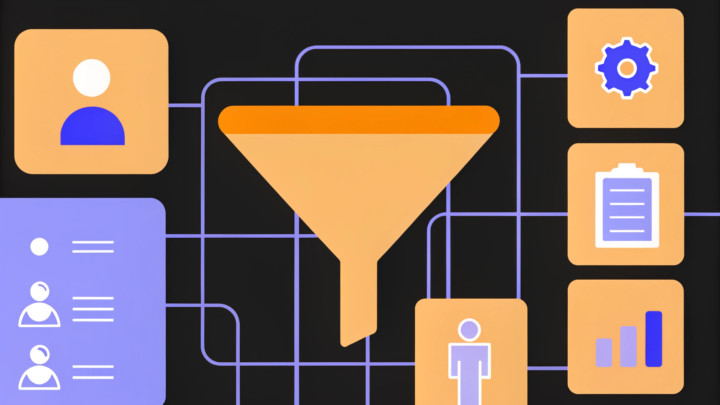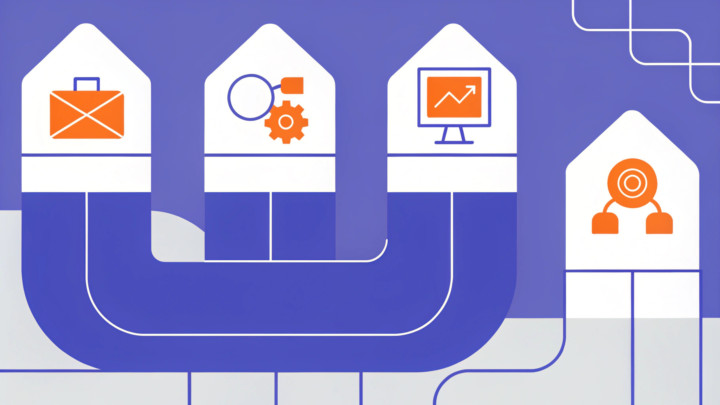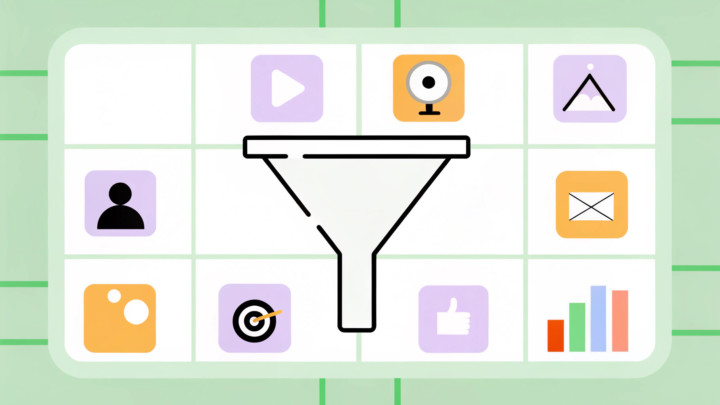Best practices in marketing automation: Proven strategies for your success

Overview
In today’s fast-paced business landscape, small business owners often grapple with the complexities of marketing automation. We understand that navigating audience understanding, personalization, multichannel strategies, and performance tracking can feel overwhelming. But here’s the good news: you’re not alone in this journey.
Imagine having automation tools at your fingertips, designed to simplify these challenges and enhance your operational efficiency. By embracing automation, you can not only engage your customers more effectively but also boost your conversion rates and foster business growth. It’s about making your life easier and your business more successful.
Think about it — what if you could streamline your marketing efforts and focus more on what truly matters? With the right strategies in place, you can transform your approach to marketing. The fix is simpler than you think, and taking that first step could lead to significant improvements.
So, why not explore how marketing automation can work for you? Start small, and see the difference it can make in your daily operations. You deserve tools that empower you and help your business thrive.
Introduction
In a world where consumer expectations are constantly evolving, we understand that running a business can feel overwhelming. Marketing automation emerges as a supportive solution for businesses like yours, striving to enhance efficiency and engagement. By harnessing advanced software, you can streamline repetitive tasks, freeing up your time to focus on strategic initiatives that truly drive growth.
Imagine being able to create personalized email campaigns or manage your social media effortlessly. The potential of automation is vast, promising not only to boost lead generation but also to enrich your customer experiences. As industry trends reveal a significant shift towards automated solutions, it’s essential to grasp the nuances of this technology. Understanding how it works can empower your organization to thrive in an increasingly competitive landscape.
This article explores the multifaceted benefits of marketing automation. We’ll delve into key strategies for implementation, the importance of truly understanding your audience, and the critical role of personalization in crafting tailored customer experiences. You’re not alone in this journey; let’s navigate it together.
Understanding marketing automation: A comprehensive overview
Marketing automation is here to help you tackle the repetitive promotional tasks that can weigh you down. We understand that managing these responsibilities can be overwhelming, but utilizing software to simplify these processes can significantly improve your operational efficiency. By automating functions like email promotion, social media management, and paid advertising campaigns, you can shift your focus from manual execution to strategic planning, giving you the freedom to grow your business.
Imagine platforms like Dashly, which excel in automating lead capture and nurturing, allowing you to engage potential clients around the clock. As HubSpot points out, 70% of marketers are looking to enhance their use of automated tools in 2025, reflecting a clear trend towards embracing technology in promotional strategies. Plus, with 83% of clients eager to share personal information for tailored content, it’s clear that automated systems play a crucial role in enhancing customer experience.
To truly reap the benefits of promotional automation, it’s essential to establish clear objectives, ensure quality data, and adhere to best practices while respecting privacy regulations. You’re not alone in this journey; over 70% of employees report that automated tools improve their workflow, showcasing the operational efficiency these technologies can bring. The integration of AI and machine learning in promotional processes is also on the rise, with many executives recognizing their potential to drive innovation and efficiency.
So, take that next step towards simplifying your promotional efforts. Embrace automation and watch how it transforms your business, allowing you to focus on what really matters — building relationships and driving growth.

The importance of audience understanding in automation strategies
Running a business is tough, and we understand the daily challenges you face. A successful implementation of best practices in marketing automation hinges on truly knowing your audience. This means diving deep into data collection about client demographics, preferences, and behaviors. Did you know that 62% of demand-gen marketers struggle with budget constraints? This highlights the urgent need for effective tools like Dashly, which can help you optimize resources through AI-driven omnichannel communication.
Imagine leveraging innovative platforms like Dashly to segment your audience effectively and tailor your messaging. For instance, consider a SaaS company analyzing user interactions across channels — website chat, email, and social media. By pinpointing which features resonate most with clients, they can create targeted campaigns that spotlight these appealing aspects. Dashly also offers conversational marketing tools like chatbots and triggered messages, which automate lead capture, qualification, and nurturing and lighten the load of manual communications for your marketing team.
Furthermore, think about the benefits of automation with a touch of personalization. With Dashly’s user behavior tracking, you’ll automatically get the full history of user’s activity on your website, all the personal data they left, and your history of communication. This way, you’ll be able to segment the audience to make more relevant offers, personalize them and send at the right time.
These personalized strategies not only enhance engagement but also significantly boost conversion rates. People are more likely to respond positively to brands that understand their specific needs. Adopting behavioral segmentation, which uses advanced tracking and AI analysis, can improve the accuracy of predicting purchase patterns by over 90%. Dashly facilitates this process by providing essential tools for advanced tracking and data analysis, alongside its marekting automation options. This empowers enterprises to anticipate client desires and design effective marketing initiatives, underscoring the importance of audience understanding in today’s dynamic marketplace. So, why not take the next step? Explore how Dashly can support your marketing automation efforts today.

Build your marketing automation strategy with Dashly:
Mapping the customer journey: A key to effective automation
Mapping the client journey is a crucial process that outlines the steps an individual takes, from initial awareness to final purchase. We understand that for many marketing teams, especially smaller ones, navigating this journey can feel overwhelming. But this visualization enables businesses to pinpoint key touchpoints where processes can greatly enhance the client experience. For instance, Dashly’s powerful tools allow for the automation of follow-up messages immediately after a lead expresses interest, ensuring timely engagement and keeping the conversation alive and relevant.
By thoroughly understanding the client journey, companies can apply best practices in marketing automation to design workflows that effectively guide prospects through the sales funnel. Imagine customizing each interaction to meet the specific needs of clients at various stages — this approach can ultimately drive higher conversion rates.
Recent research highlights an important insight: 62% of respondents do not consider themselves experts in journey mapping. This gap in expertise presents a valuable opportunity for organizations to leverage Dashly’s tools, enhancing their understanding and execution of effective journey strategies. Moreover, companies that excel in personalization, as noted by McKinsey & Company, generate 40% more revenue than their slower-growing counterparts.
By utilizing Dashly’s automation tools and applying best practices in marketing automation, organizations can facilitate this personalization, ensuring their marketing efforts truly resonate with clients. In today’s challenging economic climate, investing in client experience (CX) is crucial for maintaining reputation and success. Therefore, charting the client journey is not just advantageous; it is essential for enterprises aiming to thrive in 2025.

Personalization: Crafting tailored experiences for your customers
Personalization in promotional technology is essential for creating meaningful connections with clients. Many small business owners grapple with the challenge of standing out in a crowded market. With a remarkable 250% increase in the use of AI for promotion automation in 2023, there’s hope. Businesses are now leveraging advanced tools to effectively segment their audience and deliver customized content that resonates with individual preferences.
Here’s an example. An online school uses Dashly to analyze user interactions, recommending courses tailored to a learner’s interests and past behaviors. This targeted approach isn’t just about boosting satisfaction; it significantly enhances conversion rates. Online school Skillfactory managed to increase their conversion to lead by 44% using Dashly chatbots on their course pages.
Studies show that marketers who personalize web experiences can expect an average sales increase of 19%. It’s compelling, isn’t it? Marketing expert Thomas Radavicius highlights that 1 in 3 marketers allocate at least half their budgets to personalization, underscoring its critical role.
Yet, there’s a balancing act at play. While 38% of clients express a desire for personalized experiences, they remain cautious about sharing sensitive personal data. This reflects the ongoing challenge brands face in respecting consumer privacy while delivering tailored content. As marketers navigate these complexities, embracing effective personalization strategies will be vital for successful automation in 2025.
You’re not alone in this journey. The landscape of marketing is evolving, and with the right tools and strategies, you can create an experience that feels personal and respectful. Let’s explore how you can take the next step toward effective personalization.
Leveraging multi-channel approaches for broader engagement
In today’s fast-paced digital world, we understand that interacting with brands can feel overwhelming. Small business owners often juggle numerous channels — social media, email, websites — making it challenging to connect with clients where they prefer. That’s why executing a multichannel promotion strategy is so vital. It allows you to engage with your customers in a way that feels natural and supportive. Dashly is here to help with its powerful omnichannel communication tools, enabling marketing teams to manage communication with leads from various platforms seamlessly within one interface.
This capability not only simplifies your operations but also significantly enhances your clients’ overall experience. Research shows that a multichannel approach can profoundly impact consumer behavior and financial performance. Companies that adopt these strategies often see higher client satisfaction and retention rates. In fact, those with strong omnichannel engagement strategies enjoy a 7.5% year-over-year decrease in cost per contact, while those relying on weaker strategies see only a 0.2% decline.
Moreover, focusing on just 3 or 4 performance metrics can make a remarkable difference — companies are 49% more likely to exceed their performance targets compared to those using only 1 or 2 metrics. This data highlights the importance of best practices in marketing automation, paired with effective communication channels, to optimize customer interactions and satisfaction. As Riley Bragg wisely notes,
A multichannel approach continues to be a key driver of ROI and sustained growth for small enterprises.
By aligning your marketing efforts across different channels, you can cultivate a consistent brand presence that resonates with your audience. This approach encourages greater engagement and loyalty. With Dashly’s capabilities in managing these interactions, you can effectively leverage your multichannel strategies, ensuring that your business thrives in this competitive landscape.

Build your omnichannel marketing strategy with Dashly:
Tracking performance: The path to continuous improvement in automation
To genuinely harness the potential of automated processes, companies need to focus on best practices in marketing automation, particularly through continuous monitoring and evaluation of performance indicators. Key performance indicators (KPIs) like conversion rates, client engagement levels, and feedback are vital for assessing how effective these best practices truly are. Did you know that 49% of companies use marketing automation to enhance client experience? This statistic underscores the importance of these metrics in driving success.
With Dashly’s automations tools, businesses can simplify their marketing processes and decision-making. We’ve already mention user behavior tracking earlier. But each automation tool in Dashly comes with its own robust analytics capabilities that allow for real-time monitoring of campaign success and customer interactions, showcasing best practices in marketing automation for ongoing optimization. Your team can monitor service performance across all channels, set benchmarks for conversion rates, and pinpoint areas for improvement.
According to Pedalix’s report, 65% of B2B firms are utilizing automated systems for opt-in and registration procedures. This highlights the diverse applications of automation. Regularly analyzing performance data not only reveals areas needing enhancement but also helps companies adapt their marketing automation strategies to align with evolving organizational goals. With 39% of B2B firms planning to implement automated processes for social media management in the coming year, the importance of performance monitoring cannot be overstated in maintaining a competitive edge.
Furthermore, insights gained from thorough performance tracking can significantly inform future campaigns, ensuring they are more targeted and effective, ultimately leading to better results. In this context, businesses should prioritize monitoring KPIs like lead conversion rates, satisfaction scores, and engagement metrics. By leveraging best practices in marketing automation through Dashly’s features — such as chatbots and triggered message sequencess — companies can optimize their website funnel and engagement. Notably, the implementation of chatbots in EdPro brought $145k of extra revenue to the team. Chatbots qualified leads, captured their contacts, and managers could convert them with more personalized offers.
Disctribution of marketing automation practices:

Fostering team collaboration: A cornerstone of successful automation
Achieving an effective promotional systematization can feel overwhelming, especially when juggling the needs of different teams like advertising, sales, and client support. We understand that fostering a culture of teamwork is essential; it ensures that all departments are aligned in their goals and strategies. Regular meetings and shared tools can greatly improve communication, allowing teams to exchange valuable insights and feedback more effectively.
For instance, Dashly can be used for different purposes (lead capture, qualification, nurturing, reactivation, onboarding, etc.) and your whole team can work in one platform. Dashly doesn’t charge extra for every new user, agents seats are unlimited. This interconnected approach not only fosters teamwork but also helps keep context of all work with leads, which is crucial for customer satisfaction. Yet, it’s important to acknowledge that challenges in remote communication remain, with a staggering 98% of employees expressing dissatisfaction with video meetings conducted from home.
Moreover, data shows that organizations with strong interdepartmental collaboration are more likely to succeed in their promotional efforts. In fact, 70% of marketers plan to enhance their use of technology tools in 2024, highlighting the growing trend and the necessity for effective teamwork to facilitate this transition. However, organizations often encounter obstacles such as initial implementation costs and resistance to change, as illustrated in the case study ‘Challenges of Automation Adoption.’
Addressing these challenges is crucial for successful implementation, and promoting cooperation is key to navigating the complexities of today’s business landscape. This synergy among teams is vital for maximizing the benefits of best practices in marketing automation.

Conclusion
Exploring marketing automation reveals its transformative potential for businesses aiming to enhance efficiency and customer engagement. We understand that managing repetitive tasks like email marketing and social media can be overwhelming. By leveraging advanced software, companies can streamline these processes, allowing more focus on strategic growth initiatives. This integration not only boosts lead generation but also enriches the overall customer experience, emphasizing the importance of personalization and understanding audience needs.
Understanding the customer journey is vital for effective automation. By mapping out each step from awareness to purchase, businesses can tailor interactions that resonate with customers at various stages, ultimately driving higher conversion rates. Personalization emerges as a key strategy, with data indicating that tailored experiences significantly improve customer satisfaction and sales performance. The use of AI and machine learning further enhances these efforts, enabling businesses to predict customer behavior and preferences with remarkable accuracy.
Moreover, adopting a multichannel approach is essential in today’s digital landscape. Engaging customers across various platforms fosters a consistent brand presence and strengthens customer loyalty. We recognize that tracking performance metrics is equally crucial for continuous improvement; businesses must regularly evaluate their marketing strategies to adapt to changing market dynamics.
Lastly, fostering collaboration among teams is fundamental to the success of marketing automation initiatives. A unified approach ensures that marketing, sales, and customer support departments work together effectively, enhancing communication and optimizing customer interactions. As you navigate the complexities of marketing automation, embracing these strategies will not only streamline operations but also position you for sustained growth in an increasingly competitive environment.








